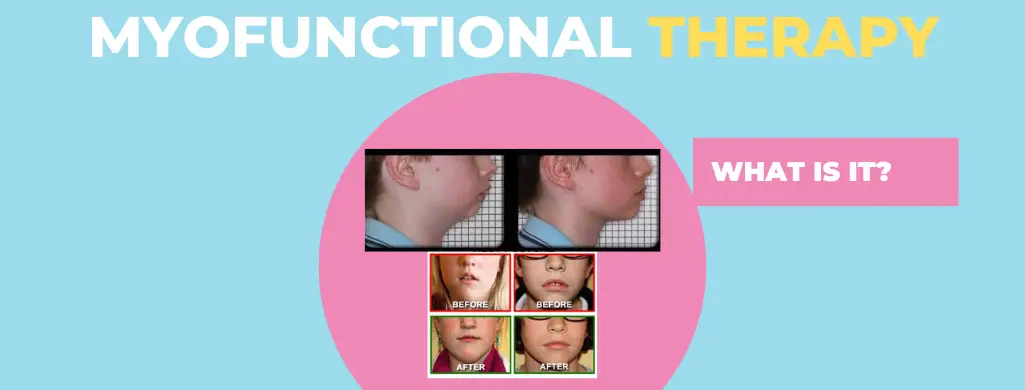Myofunctional therapy is a type of treatment that focuses on correcting improper oral habits, called orofacial myofunctional disorders (OMDs), and improving overall oral function. These habits may include improper swallowing, mouth breathing, and tongue thrusting, which can lead to a variety of health issues.
In recent years, the demand for this therapy has increased as more people are realizing its potential benefits. If you’re curious about this type of therapy and how it works, keep reading. In this article, we’ll explore what myofunctional therapy is and how it can help improve your oral health and overall well-being.
What is myofunctional therapy used for?
Myofunctional exercises can be used to treat a number of orofacial myofunctional disorders, including:
- poor facial posture
- difficulty swallowing
- poor speech clarity
- snoring
- obstructive sleep apnea
Myofunctional exercises include facial muscle exercises, tongue and throat exercises, lip and jaw strengthening, and breathing techniques.
By correcting improper oral habits, it can help reduce the chances of developing OSA and other health problems associated with it. Additionally, this type of therapy may help improve breathing patterns during sleep. This is because it helps open up the airways by improving nasal breathing and how the mouth functions. It also may be needed to maintain/help orthodontic treatment to fix crooked teeth issues.
Does myofunctional therapy work?
Yes, the effectiveness depends on the severity of the condition and how well the patient is able to adhere to their treatment plan. In general, this type of therapy can help improve breathing patterns during sleep, reduce snoring, and improve overall health. It also helps correct improper oral habits that can lead to various health issues, such as sleep apnea.
Studies have shown that myofunctional therapy can help reduce the symptoms of obstructive sleep apnea in adults. One study found that patients who underwent this type of treatment experienced a significant reduction in OSA severity after six months. Additionally, studies have found that it can help reduce snoring and improve sleep quality over time.
Most people are advised to get a therapist before starting any of these tongue and throat type exercises in order to have successful treatment.
What is a myofunctional therapist?
A myofunctional therapist is a trained healthcare professional who specializes in the treatment of improper oral habits and related health issues. These professionals can help diagnose and treat conditions such as tongue thrusting, mouth breathing, incorrect facial structure, and improper swallowing. They also use techniques to help improve facial posture, oral rest posture, speech clarity, and articulation.
Myofunctional therapists use a variety of techniques to help correct improper oral habits. These techniques may include exercises designed to strengthen the facial muscles used for proper swallowing, tongue placement, and improve nose-breathing. Additionally, they may use appliances that help keep the tongue in place during sleep or when speaking.
Therapy sessions are typically conducted on an individual basis, although group sessions may be offered depending on the patient’s needs.
Is myofunctional therapy covered by insurance?
Myofunctional therapy is becoming more widely accepted and may be covered by insurance in some cases. Insurance coverage for this type of therapy varies depending on the provider and the patient’s individual policy. It’s important to contact your insurance provider to find out if myofunctional therapy is covered before seeking treatment.
In some cases, patients may qualify for reimbursement or discounts when visiting a trained myofunctional therapist. Additionally, many therapists offer payment plans to make the cost of treatment more affordable. Patients should also be aware that some insurers require pre-approval before they will cover any treatments.
How much does myofunctional therapy cost?
The cost of myofunctional therapy can vary depending on the type of treatment needed and the therapist’s experience level. Generally, sessions with a myofunctional therapist will range between $50-$150 per hour. Depending on the patient’s needs, they may need multiple sessions to achieve their desired results. Some therapists offer package deals or discounts for multiple-session purchases. Additionally, some insurance plans may cover a portion of the treatment costs.
Patients should also be aware that there are additional fees associated with myofunctional therapy such as lab tests, imaging scans, and other related expenses. Furthermore, patients may need to purchase special appliances that help keep the tongue in place during sleep or when speaking. The cost of these appliances can range from $100-$400.
How long does myofunctional therapy take?
Myofunctional therapy is a long-term treatment plan, and the length of time it takes to achieve results can vary from one patient to another. It generally takes several weeks before patients begin to notice any changes in their breathing patterns or snoring habits. The duration of treatment can also depend on the severity of the condition and how well patients adhere to their treatment plan. Though, specifically it last anywhere between 6-12 months.
In some cases, improvements can be seen after a few weeks, while more severe cases may require more time for noticeable changes to occur. Additionally, many practitioners recommend that patients continue with therapy after they have achieved initial success in order to maintain their results over time. Overall, this type of therapy is an effective way to reduce sleep apnea and improve overall health.
Conclusion
It’s important to note that myofunctional therapy can be used as an adjunct treatment in conjunction with other treatments for sleep apnea. However, it is not a cure for sleep apnea and should not be viewed as a standalone treatment option. Additionally, the effects of therapy may not be noticed right away and will take time to become noticeable.
The long-term effects of myofunctional therapy depend on the patient’s adherence to their treatment plan and how well they implement the exercises and appliances prescribed by their therapist. Although results may not be immediate, many patients report improved sleep habits over time, including a decrease in snoring and a reduction in symptoms associated with sleep apnea. Additionally, continuing with myofunctional therapy after initial success is important for maintaining the positive results achieved.


